Episodes
![Change Your Mindset—Raise Your Rates [Danielle Hayden] - Episode 248](https://pbcdn1.podbean.com/imglogo/ep-logo/pbblog3132020/WSPodcast_LI_PodbeanGraphic_episode248_Danielle_Hayden_4gz9v6_300x300.png)
Wednesday Jan 19, 2022
Wednesday Jan 19, 2022
Does the thought of raising your rates leave you saying “Uh-uh, no way?” Are you worried that the covid-induced interior design “bubble” may pop? What if you raise your prices and the bubble does burst? These questions contribute to the mindset struggles designers face when considering raising their rates. So how do you determine if you should make a change? In this episode of Wingnut Social, Danielle Hayden shares some exercises that can help you make the decision.
Danielle is a reformed CFO on a mission to help rule-breaking female entrepreneurs understand their numbers to gain confidence to create sustainable profits. She’s the co-owner of Kickstart Accounting, where she helps her clients with bookkeeping, financial analysis, and provides education to help them make informed decisions.
What You’ll Hear On This Episode of Wingnut Social
[3:22] Mini News Sesh: An algorithm-free Instagram feed?
[8:20] Learn more about Danielle Hayden
[15:28] Thinking about raising your rates? Do these exercises.
[22:50] Determining your take-home pay depends on your goals
[30:12] It’s time to change your mindset about raising your rates
[36:47] The What Up Wingnut! Round
[41:38] Blooper Reel!
Connect with Danielle Hayden
Kickstart Accounting Inc.
Connect with Danielle on Instagram
The Entrepreneur Money Stories Podcast
Resources & People Mentioned
Built to Sell by John warrilow
Wingnut Social Episode #26
Thinking about raising your rates? Do these exercises.
Exercise #1: How much of your time and energy goes into a single project? What are your average operating expenses per month? Multiply the time you spend in your business by your hourly rate. Add your operating expenses to that number. This is your break-even number. Divide that by your number of clients each month. This gives you an idea of whether or not you’re profitable.
Secondly, what are your goals? Is it your goal to outsource parts of your business, such as social media or bookkeeping? Do you want to be hands-on with every project? Or do you want to oversee a team of designers? What will that cost you?
Grab a piece of paper now and add up how many clients you need to take on to hit the numbers you need to reach your goals. You may see that if you don’t raise your rates, you’ll never meet those goals. It’s a clear way to see whether or not you need to raise your prices.
Exercise #2: Danielle recommends that you go into your accounting system and run a P&L report for the last 24 months. Looking at your history helps you determine your average spend per account and what you need to spend to keep your business moving forward. Your history helps determine the steps you take today.
Change your mindset about raising your rates
If you don't want to raise your rates, that’s okay. But think about your goals. What if you can serve fewer clients at a higher price tag and be happier doing it? You may lose a client in the short term but the long-term impact will be worth it. Your mindset will change. The client paying more for your service will value you and your brand.
Darla doubled her rates after she gained some experience which helped her land more clients. Their perception of her value increased with her rates. You don’t have to make a bold move like Darla’s. Figure out what works and what doesn’t, track the numbers, and make an adjustment. There’s no such thing as failure—there is learning and growing. Changing your mindset and changing your rates can be transformative.
Connect With Darla & Wingnut Social
www.WingnutSocial.com
On Facebook
On Twitter: @WingnutSocial
On Instagram: @WingnutSocial
Darla’s Interior Design Website
Check out the Wingnut Social Media Lab Facebook Group!
1-786-206-4331 (connect with us for your social media marketing needs)
Subscribe to The Wingnut Social Podcast on iTunes, Google Podcasts, or TuneIn
Audio Production and Show notes byPODCAST FAST TRACKhttps://www.podcastfasttrack.com
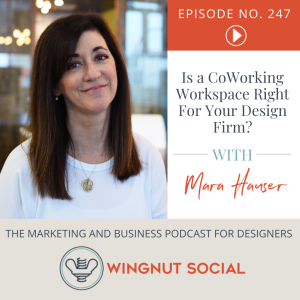
Wednesday Jan 12, 2022
Wednesday Jan 12, 2022
The pandemic shutdown sent so many of us home to work but designers were a bit ahead of that curve, generally speaking, since many worked from home already. But regardless how we got there, home can become a bit lonely and distracting when it comes to productivity and accomplishment. How do you deal with it? Mara Hauser says a CoWorking space may be your solution. Mara is a designer herself. She guides her client’s big ideas into executable designs that focus heavily on brand-building and high-level analysis, including programming, product and amenities mix, adjacency diagrams, and determining “who you serve.” But she’s also CEO of 25 North CoWorking Spaces and understands the powerful benefits a coworking space can be to anyone, including designers and their teams. On this episode we discuss the possibilities, how to make the transition, how to benefit the most from involvement at a CoWorking space, and more. Listen up, Wingnuts!
What You’ll Hear On This Episode of Wingnut Social
[1:02] This episode’s topic: Gettin’ out of the house!
[2:48] The Mini-News Sesh!: Facebook profiles can become professional profiles
[6:51] Who is Mara Hauser?
[11:09] Is the trend toward home-working going to continue?
[13:12] A hybrid work approach interior designers may be able to use
[20:08] How large of a design firm could use this model?
[22:20] How important is the design aspect of a coworking or office space?
[25:22] Mitigating the sense of anxiety that can occur making this transition
[30:15] Reasons you will benefit from utilizing a coworking space
[33:20] The WHAT UP WINGNUT? round
Connect with Mara Hauser
25 North Coworking Spaces - Mara’s company
Workplace Studio Interior Design - Mara’s design studio
Follow Mara on Twitter
Resources & People Mentioned
BOOK: Shoe Dog by Phil Knight
Wingnut episode with Rex Rogasch - Hospitality Design
The Advantages and Disadvantages of Working From Home
If you’ve worked at home, you know the pain. Fido is barking outside your door. The cat walks across your keyboard when you’re out of the room. Netflix is right out there in the living room, beckoning you to continue your latest binge. These are some of the irritations but there are also limitations. It’s hard to host professional meetings at home, especially with clients. It’s also problematic to have your team work out of your home without turning your street into a used car lot every day. Mara says these are exactly the things a CoWorking space is designed to solve. Listen to learn if a CoWorking option is a good fit for you. You might be surprised how adaptable and collaborative it could be for you and your team.
Multipurpose spaces are massively important in your working space and the CoWorking space you choose
Most designers understand the principles behind good design (of course), so they get the realities around spaces designed to serve specific purposes. That reason alone may have you on the skeptical side of the fence when it comes to using a CoWorking space. But it doesn’t have to, especially when it comes to Mara’s locations. Being a designer, she’s done everything in her team’s power to create flexible spaces that can be transformed into what each client needs. They utilize casters to move things around and remake the space. The lighting, HVAC, and amenities are provided with comfort and productivity in mind. They also include outdoor work and meeting spaces to enable teams to make the most of fresh air and natural surroundings. If you were to visit one of her locations you would be impressed with the flexibility and effectiveness of the spaces she’s created. Listen to this episode to learn if a CoWorking space is right for you and your team!
Connect With Darla & Wingnut Social
www.WingnutSocial.com
On Facebook
On Twitter: @WingnutSocial
On Instagram: @WingnutSocial
Darla’s Interior Design Website
Check out the Wingnut Social Media Lab Facebook Group!
1-786-206-4331 (connect with us for your social media marketing needs)
Subscribe to The Wingnut Social Podcast on iTunes, Google Podcasts, or TuneIn
Audio Production and Show notes byPODCAST FAST TRACKhttps://www.podcastfasttrack.com
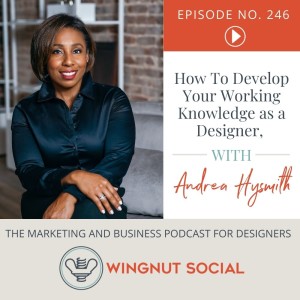
Wednesday Jan 05, 2022
Wednesday Jan 05, 2022
One of the many challenges for up-and-coming designers (and those of us who have been in the industry for a while, too) is in the area of “working knowledge.” There’s a LOT to know and it seems like nothing but time is going to help you know it. But the guest on this episode proves that even though she’s been in the industry for over 20 years, there are clear things you can do to accelerate your learning curve.
Andrea Hysmith of A.S.H. Designs (in Ellicott City, MD) is an Interior Specialist, Kitchen and Bath Designer, Manufacturer Representative, Speaker, and Presenter, and has been sharing her knowledge of luxury design for over 20 years. She focuses on residential and light commercial spaces and recently opened her own design space in Ellicott City as the first woman of color to do so. She’s a hard-working, hustling woman who has done the work necessary to educate herself about her craft, all for the sake of serving her clients with excellence. You’ll learn a lot about developing your own working knowledge, faster, from her intentional approach, so be sure you listen.
What You’ll Hear On This Episode of Wingnut Social
[0:42] Where I’ve been… answering the common question, “Why the break???”
[2:09] The Mini-News session: Instagram Reels (reply with another reel)
[5:16] Andrea Hysmith: Designer extraordinaire
[13:04] The movement to curate antiques and how Andrea got into it
[21:25] What is “Certified Aging in Place?”
[28:27] How did Andrea become an independent manufacturer rep?
[36:58] Why it’s important to be true to yourself as you being your design career
Connect with Andrea Hysmith
Andrea’s company: ASH Design in Ellicott City, MD
Andrea on Instagram
Resources & People Mentioned
Andrew Joseph
Toma Clark Haines
Certified Aging In Place Specialization
T.D. Jakes
Highpoint Market
What They Don’t Teach You In Design School Facebook Group
BOOK: Wild by Cheryl Strayed (affiliate link)
Taking a proactive approach to design by getting into the trenches
It’s easy to feel that you are handicapped when you need to know more about a specialized area of design but simply don’t. Andrea never let that stop her. She’s a “go get it” kind of woman. She takes the initiative to find the resources and open the doors that will provide her with the knowledge she needs — and you can do the same.
For example, at one point in Andrea’s career, she needed to know more about custom cabinetry so she reached out to establish a relationship with a custom cabinet builder and worked shifts in his facility to learn what she needed to learn. She’s done the same with painters, a plumbers, and other specialized tradesmen, all for the sake of educating herself at the source. Though it may seem that’s a lot of irons in the fire, Andrea says it’s all cohesive if you keep things integrated within a common goal or mission.
Special certifications can help you stand out in a crowded area
Andrea holds a special certification that Darla had never heard of. The National Association of Home Builders offers a “Certified Aging in Place Specialist” certificate and Andrea is one of those who have completed the course they offer. It’s a specialty in the design and refurbishment of homes to enable those who are aging or otherwise disabled to continue to live in their homes rather than having to move.
Andrea says this is especially important to her because she has clients who have been with her for many years. Her certification enables her to serve them in new, fitting ways as they age and the relationship continues. She’s also had people reach out to her specifically because she holds the certification, and at one community event a realtor who works primarily in retirement communities asked if Andrea would serve as a recommended service provider for those the realty group serves. Are there certifications that would serve the community where you work or the clientele you specialize in serving? If so, go get them!
Connect With Darla & Wingnut Social
www.WingnutSocial.com
On Facebook
On Twitter: @WingnutSocial
On Instagram: @WingnutSocial
Darla’s Interior Design Website
Check out the Wingnut Social Media Lab Facebook Group!
1-877-WINGNUT (connect with us for your social media marketing needs)
Subscribe to The Wingnut Social Podcast on iTunes, Google Podcasts, or TuneIn
Audio Production and Show notes byPODCAST FAST TRACKhttps://www.podcastfasttrack.com
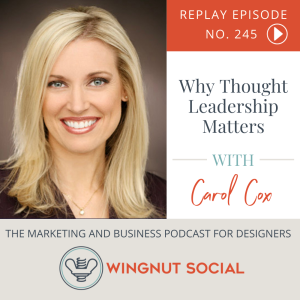
Wednesday Dec 01, 2021
Wednesday Dec 01, 2021
Carol Cox is the founder of Speaking Your Brand®. Her mission is to help women create thought leadership platforms to have the impact they desire in their field. But how do you get to that point? Is becoming a thought leader worth the time and effort? In this episode of Wingnut Social, Carol speaks about the power of sharing your personal experiences, what container you should use for your thought leadership, and the basics of her VOICE method. Don’t miss this awesome replay.
1v7P9R7TkavQBnV12gvh
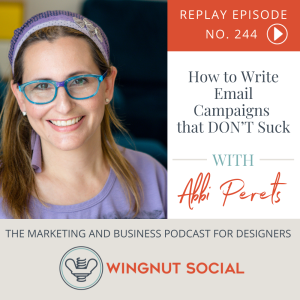
Wednesday Nov 24, 2021
Wednesday Nov 24, 2021
What does a successful email marketing campaign look like? How do you get people to read your emails and not just immediately trash them? Abbi Perets—The founder of Successful Freelance Mom—shares the secret to her successful email campaigns in this special replay of the Wingnut Social podcast! She’ll cover her TWO big rules, what makes people open emails, and why it’s important for there to be a purpose behind your content. Don’t miss it!
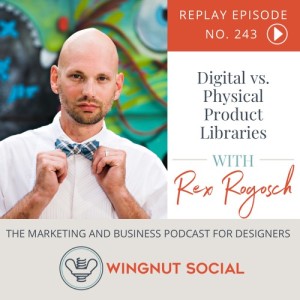
Wednesday Nov 17, 2021
Wednesday Nov 17, 2021
With over 20 years of experience in the design industry, Rex Rogosch knows a thing or two. In his expert opinion, digital product libraries are the way of the future. Sourcing online is a breeze and many clients already have Pinterest boards plastered with the furniture and pieces they love. But is there still a place for physical product libraries? Are you ready to transition to a digital library? Learn more from Rex in this Wingnut Social Replay!
![REPLAY: Up-Level Your Social Media Marketing with Pinterest [Kate Ahl] - Episode 242](https://pbcdn1.podbean.com/imglogo/ep-logo/pbblog3132020/999A5FB9-B429-49C7-90B3-039F1939E7CB_300x300.jpeg)
Wednesday Nov 10, 2021
Wednesday Nov 10, 2021
When it comes to social media, Instagram gets a lot of the focus these days. But you can’t forget how successful Pinterest can be for interior designers. So in this Wingnut Replay, you’ll get to revisit episode #218 with none other than Kate Ahl—Ahl about boosting your social media marketing with Pinterest. Check it out!
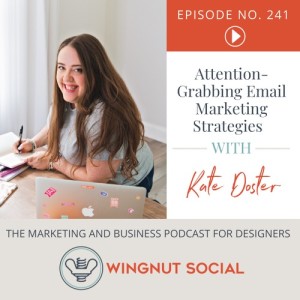
Wednesday Nov 03, 2021
Wednesday Nov 03, 2021
Is email marketing still relevant? How do you grow and nurture your email list? How important are lead magnets? These are just a few of the many topics Kate Doster covers in this episode of the Wingnut Social podcast. If you’re struggling to build email campaigns that convert, Kate is the go-to expert. Don’t miss her take!
What You’ll Hear On This Episode of Wingnut Social
[1:24] Mini News Sesh: Facebook Update
[3:40] Learn all about Kate Doster
[4:44] Is email marketing still relevant?
[7:18] How to compose a “Yeah, but…” email
[12:54] The lowdown on email lists
[17:33] How to attract the right subscribers
[20:27] Why you should work with Wingnut Social
[21:31] The importance of lead magnets
[26:13] How to grow and nurture your email list
[29:24] How often to use a call-to-action
[31:51] How the Apple iOS update impacts email
[33:41] The What Up Wingnut Round
[36:16] How to connect with Kate Doster
[40:12] Blooper Reel!
Connect with Kate Doster
The Inbox Besties Podcast
Kate Doster’s Courses
Connect with Kate on Instagram
Follow Kate on Twitter
Resources & People Mentioned
ActiveCampaign
MailChimp
ConvertKit
MailerLite
Year of Yes by Shonda Rhimes
Your emails need to grab someone’s attention
Why is someone going to their inbox? They’re bored, procrastinating, stuck watching their kids boring tv shows—who knows. But Kate knows that people go to their inbox for a hit of dopamine. Because you’re shooting for a dopamine hit, you want to give them a quick tip or anecdote. When people go to their inbox, they want a quick escape.
People think emails need to be a large elaborate story. It doesn’t need to be that. But you do want to make sure your emails are relevant. If someone signs up for Kate’s email list, they get emails about email marketing and sales psychology. If she started talking about her fitness journey to her subscribers, people wouldn't care. They’d unsubscribe.
That being said, you can give them a random piece of information that’s tied back to your topic. You must be entertaining and stay true to your brand. You have to treat your subscribers like they’re one in a million, send relevant emails, and include the hit of dopamine. How can I make this person feel good today? How can I make them interested? How can I get them thinking? Start with an attention grabber.
Kate’s secret sauce: The “Yeah, but…” email
You want to give your subscribers something that answers the, “Yeah, but…” question. Yeah, I want this, but this is in the way. People always have “yeah, buts…” You have to identify what’s holding people back from making a decision. You can then share simple guides that give them the answer to their questions and leave them saying, “She gets me. She understands.”
If someone is truly interested in getting their living room redesigned but can never agree on something with their spouse, you can share a guide that touches on how to mesh two different styles. Think of something that’s holding people back. Listen to hear what Kate’s specific tips for interior designers are!
The importance of lead magnets
If you have an interior design blog and want to share some dupes for a crazy expensive couch, that could be a lead magnet. You want to share an exclusive thing that people can only get if they join your email list. It can be hard to brainstorm ideas, so Kate shares some genius hacks.
If you have a popular and relevant piece of content, upcycle it. If something on social media got a lot of engagement, can you turn it into a PDF? You can use that in an email. It doesn’t have to be reinventing the wheel. Create permanent versions of things that are excelling and offer that as your freebie.
Another pro tip? List out all of the excuses and concerns that people have around what you’re ultimately going to sell. Is it working with an interior designer? Is it sourcing? Is it doing something on a budget? Is it finding high-end dupes? If you aren’t sure, look at 2 and 3-star reviews on Amazon or snoop around in Facebook groups. What are people complaining about? When you address the “Yeah, but...” that someone has, it works. It all comes from knowing your ideal client. You want someone to say, “How did you know that’s what I needed?”
Connect With Darla & Wingnut Social
www.WingnutSocial.com
On Facebook
On Twitter: @WingnutSocial
On Instagram: @WingnutSocial
Darla’s Interior Design Website
Check out the Wingnut Social Media Lab Facebook Group!
1-877-WINGNUT (connect with us for your social media marketing needs)
Subscribe to The Wingnut Social Podcast on iTunes, Google Podcasts, or TuneIn
Audio Production and Show notes byPODCAST FAST TRACKhttps://www.podcastfasttrack.com
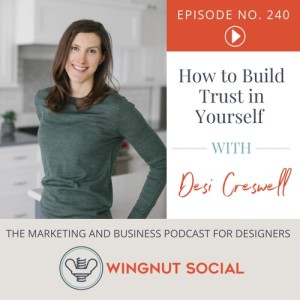
Wednesday Oct 27, 2021
Wednesday Oct 27, 2021
Desi Creswell is a business coach who specializes in working with interior designers. As a coach, Desi doesn’t tell you what to do. She asks high-quality questions to help you uncover what you know to be true for yourself that aligns with what you want to create for your business. As she draws that out of you, you will learn to do it for yourself.
In a coaching relationship, you tend to view your coach as a parental figure—someone who has all the answers and knows what’s best. But Desi doesn’t want her clients to solely rely on her for decision-making. She wants to equip her clients with the tools to make empowered decisions about their own businesses. That starts by learning to trust yourself. She shares why this is so important in this episode of Wingnut Social!
What You’ll Hear On This Episode of Wingnut Social
[0:49] Brought to you by Wingnut Social!
[2:05] Mini News Sesh: IGTV is no more
[5:13] Learn to ask yourself quality questions
[9:24] How to determine when you need help
[12:18] Why you need to trust your gut
[18:39] How Wingnut Social can help YOU
[20:24] How to navigate mastermind groups
[23:01] How many opinions should you seek out?
[32:00] Desi’s What Up Wingnut answers!
[34:47] How to connect with Desi Creswell
[38:20] Blooper Reel!
Connect with Desi Creswell
Desi’s Coaching Website
Get on Desi Creswell’s Coaching waitlist
Take back control of your day with Desi’s Daily Planner
Have a conversation with Desi on Instagram
Connect with Desi on LinkedIn
Resources & People Mentioned
Episode #172: Desi Creswell Shares How to Cultivate a Healthy Mindset
Effortless by Greg McKeown
Why you need to trust your gut
If you’re researching between project management tools, you talk to people who use the systems to see how the product works for them, right? Does it do what it needs to for their business? What are the best parts of the software? Ultimately, you have to make the decision. But you may continue to find yourself asking questions, hoping someone else makes the decision for you. The problem becomes that you’re seeking something externally that you need to provide for yourself internally.
The struggle is that as soon as you make a decision, there’s something at stake. It can be scary. You may question your decision or get an outcome you didn’t like. The #1 reason people don’t want to make a decision is that they’re afraid of the backlash they’ll get from themselves if they make the “wrong decision.” Will you beat yourself up? The truth is that you will make bad decisions—in life and business. So how will you handle it?
Build trust in yourself by taking baby steps
Desi suggests practicing decision-making with little things. Trust yourself in the little decisions, even something as simple as what you’re eating for lunch. It allows you to build the muscle and apply it to bigger decisions. Then, once the decision is made, trust that you made the right decision no matter what unfolds afterward.
You can decide that there are no bad decisions. There are just decisions that you make, you get results from them, you learn from them, and you move on. When you allocate the responsibility to someone else, you’re blaming them for the outcome. You have to take responsibility for the results of your decisions.
But it all starts with getting out there and doing it. You’ll have some things that won’t work out how you think they should. For example, when Darla launched Wingnut Premium, it didn’t take off how Darla expected it to. So she pulled the plug. It was an experiment that she chose to do that didn’t work out as planned and that’s okay. Darla is moving on to bigger and better things. Darla actively chose not to see it as a failure but a learning lesson.
Connect With Darla & Wingnut Social
www.WingnutSocial.com
On Facebook
On Twitter: @WingnutSocial
On Instagram: @WingnutSocial
Darla’s Interior Design Website
Check out the Wingnut Social Media Lab Facebook Group!
1-877-WINGNUT (connect with us for your social media marketing needs)
Subscribe to The Wingnut Social Podcast on iTunes, Google Podcasts, or TuneIn
Audio Production and Show notes byPODCAST FAST TRACKhttps://www.podcastfasttrack.com
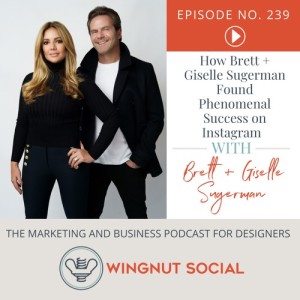
Wednesday Oct 20, 2021
Wednesday Oct 20, 2021
Brett + Giselle Sugerman are the super-couple behind B&G Design Inc., an award-winning Miami-based interior design firm. They’ve been featured on NBC, CBS, and HGTV—true movers and shakers in the industry. They share their design expertise across multiple social media platforms and have 57,000 followers on Instagram alone. In this episode of Wingnut Social, they share how they’ve found success with their marketing endeavors.
What You’ll Hear On This Episode of Wingnut Social
[2:09] Mini News Sesh: Instagram Favorites
[4:14] Learn more about Brett and Giselle Sugerman
[8:52] How they learned from their mistakes work-life balance
[12:06] Advice for couples going into business together
[16:11] Their phenomenal success with Instagram
[23:30] Learn more about B&G Unfiltered
[26:16] Curated authenticity on social media
[33:10] The What Up Wingnut! Round
[34:30] How to connect with Brett and Giselle
[38:25] Wingnut Social has some openings!
[39:31] Blooper Reel!
Connect with Brett Sugerman + Giselle Loor-Sugerman
B+G Design
B+G Design on Instagram
B+G Design on Facebook
Brett’s Music on Spotify
Resources & People Mentioned
How to Balance your Marriage + Business + Self [with LMFT Amber Hawley]
The Celestine Prophecy by James Redfield
One Hundred Years of Solitude by Gabriel Garcia Marquez
How they found phenomenal success with Instagram
Originally, when Brett and Giselle started marketing on social media, it was trial and error to see what worked. Right now, their brand is a lot of people working together to make things happen. They continuously change and evolve depending on what’s happening in the world. What’s helped them a lot? Promoting their posts. They are always tweaking their audience and age groups and analyzing the results. What photos did well? Did before and after slides do well? Did supporting stories or reels help with engagement?
Giselle emphasizes that it’s important to stay true to who you are and who you are as a brand. People want to know the person and the personality behind the brand. What inspired you? What is your life about? So they build their life into their social media to show their interests. Showing your personality means that more of your ideal clients will connect with and seek you out. Their tactics are obviously working, right? 57,000 people follow them on Instagram alone and that’s no easy feat.
Curated authenticity on social media
Whatever you’re sharing on your social media, make sure it’s descriptive of your life and your business. They post standard before and after photos to show design transformations. Giselle loves styling their home for the holidays and building tablescapes. They also share their high-end luxury designs. Through it all, they intermix content that shows who they are.
They emphasize that if you’re trying to build a following, you must also tag and give credit to everyone involved in a project. It will open up your audience. There is plenty of business to go around and you can’t be afraid to share your expertise with others. They embrace the mantra “Share the love.”
Another tip? Be consistent with posting and sharing. Be true to your aesthetic. Don’t be afraid to show who you are as a designer and an individual. Be true to who you are because there truly is an audience for everyone. Try to stand out and be unique because people are looking for different things. People can taste authenticity.
Giselle and Brett also take a deep-dive into how they’ve found success building a successful business while balancing life as a married couple with a family. Don’t miss this episode!
Connect With Darla & Wingnut Social
www.WingnutSocial.com
On Facebook
On Twitter: @WingnutSocial
On Instagram: @WingnutSocial
Darla’s Interior Design Website
Check out the Wingnut Social Media Lab Facebook Group!
1-877-WINGNUT (connect with us for your social media marketing needs)
Subscribe to The Wingnut Social Podcast on iTunes, Google Podcasts, or TuneIn
Audio Production and Show notes byPODCAST FAST TRACKhttps://www.podcastfasttrack.com
![Pivot Your Business with a Strategic Business Coach [Like Michele Williams] - Episode 238](https://pbcdn1.podbean.com/imglogo/ep-logo/pbblog3132020/C7AED0B4-15BB-4AE5-964B-BB8235AFEB22_300x300.jpeg)
Wednesday Oct 13, 2021
Wednesday Oct 13, 2021
Michele Williams is a strategic business coach who works with designers to help them create a strategic focus for their business, finances, and all decision-making. She firmly believes when you have a clear idea of where you want to go, you can get clear steps forward in place. She empowers business owners to take back the reins.
When Darla came to Michele, she was struggling through a messy divorce while managing a full-time design business, Wingnut Social, and a podcast. Darla was ready to break and felt out of control. How was Michele able to guide her through her next steps? What did Michele do that helped Darla reclaim control of her businesses? How can she help you, too? Listen to this episode to learn more!
What You’ll Hear On This Episode of Wingnut Social
[4:37] Mini News Sesh: Content Facebook likes
[8:40] Learn more about Michele Williams
[13:37] What makes your heart beat?
[26:32] Check out Build Lane for custom furniture!
[28:00] Get on Wingnut Social’s waitlist—you won’t regret it
[29:42] How to find the right coach for you
[32:00] How to pivot if you can’t afford a coach
[43:43] The What Up Wingnut! Round
[47:26] Blooper Reel!
Connect with Michele Williams
Scarlet Thread Consulting
Profit Is a Choice Podcast
Scarlet Thread on Facebook
Scarlet Thread on Instagram
Michele on LinkedIn
Resources & People Mentioned
Capasso Interiors (Get a 15% discount on your first retainer with the Code DARLA15 until October 21st)
Creating a Sustainable Design Business through Profit First with Michele Williams
The Vision Driven Leader by Michael Hyatt
How to decide what you love—and what you can live without
Darla was running three businesses—the design business, the podcast, and Wingnut Social. Far too much for one person to handle. None of the businesses could function without her in them. What was her first step? Michele told her to take a step back, pull her head out of the day-to-day, and decide what she loved doing.
Michele emphasizes “Stop building businesses that you don’t like. Stop building businesses that drain you. Stop building businesses that ask more than you’re willing to give. Start building businesses that you love with an intention and with a strategy.” That’s what Michele helped Darla work through.
Which business did she want to put her time and attention into? What made her heart beat faster, that she felt passionate about? What wouldn’t she regret losing? Michele notes you must “Clear everyone else’s voice and hear yours.” You can’t make a business profitable if your heart isn’t in it.
Michele isn’t there to make you a better designer, social media expert, or podcaster. She is there to help her clients run their businesses and make them better business owners. You develop a great business by having a strategy that leads to goals that lead to a plan. It becomes a framework for decision-making. The strategy allows you to say “yes” or “no” and not feel guilty about the decisions you’re making.
How to pivot your business if you can’t afford a coach
Michele says the first step is easy: find someone you trust and consume all of the free information you can from them. Michele—and most coaches out there—offer some sort of free resources. Michele has a weekly podcast (Profit is a Choice) that shares 100% free content. She produces newsletters with actionable tips. You can write down takeaways and start using the free advice that coaches share.
Michele has met numerous people who’ve listened to her for years, implemented everything she’s recommended, and got to a place where they could hire her. What else can you do? Invest in courses. Courses can help get you where you want to go so you can make enough money to do the next thing.
Are you pivoting in your business because you want to—or someone told you that you have to? You need some understanding of why you need to pivot. Then you need to decide to pivot in a direction that will make you happy and joyful. You create a strategic plan and vision of what could be. Then you put one foot in front of the other and gain clarity.
When you’re creating a vision, Michele emphasizes that you have to believe that the best is yet to come. If you’d like someone to guide you along the way, reach out to Michele today!
Connect With Darla & Wingnut Social
www.WingnutSocial.com
On Facebook
On Twitter: @WingnutSocial
On Instagram: @WingnutSocial
Darla’s Interior Design Website
Check out the Wingnut Social Media Lab Facebook Group!
1-877-WINGNUT (connect with us for your social media marketing needs)
Wingnut Social Podcast Sponsor: Build Lane
Looking for a great custom furniture option? Check out Build https://buildlane.com/
Subscribe to The Wingnut Social Podcast on iTunes, Google Podcasts, or TuneIn
Audio Production and Show notes byPODCAST FAST TRACKhttps://www.podcastfasttrack.com
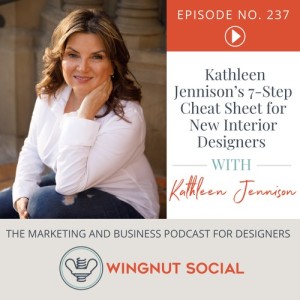
Wednesday Oct 06, 2021
Wednesday Oct 06, 2021
Kathleen Jennison experienced a traumatic event that left her between two choices: living life by design or living life by default. She chose the former and has never looked back. It led her to make a drastic career change from an accountant to an interior designer. What led to the change? And how did she learn the interior design business in a time when there were no podcasts, Facebook groups, or coaches? She shares 7 critical steps she made—and what new interior designers should do—in this episode of Wingnut Social!
What You’ll Hear On This Episode of Wingnut Social
[4:10] Mini News Sesh: Instagram map search
[6:48] Kathleen Jennison’s career story
[14:24] The don’ts of changing careers
[21:11] Build Lane is changing the custom furniture game
[22:38] Hire Wingnut Social for your social media marketing needs
[24:22] Switch to accounting software for interior designers
[26:09] Find the one guru that resonates with you
[27:46] Attend your local markets to network and learn
[29:34] Hire a professional photographer to document your work
[31:43] Consider opening a storefront for your interior design business
[34:33] Outsource anything outside of your zone of genius
[36:11] Kathleen’s What Up Wingnut Round!
[38:34] How to connect with Kathleen Jennison
[40:43] Blooper Reel!
Connect with Kathleen Jennison
Kathleen’s website
Follow on Twitter
Friend on Facebook
Follow on Instagram
Resources & People Mentioned
Rick Steves’ Travel Guide
Curio Electro
Studio Designer
Mydoma Studio
Designer Link
Kathleen’s transition from accountant to interior designer
In 2006, Kathleen came around a hairpin turn to encounter a car that was parked, taking photos. To avoid the car, Kathleen veered towards the side of the road—right over a cliff. She fell 200 feet into a ravine. The last thing she remembered was the airbag deploying and thinking “This is not gonna be good.”
Kathleen was airlifted to UC Davis medical center. She had a traumatic brain injury, lost the vision in her right eye, and had broken many bones. She also struggled with short-term memory loss. Thankfully, it came back—but she had to relearn many things.
Because of the accident, Kathleen lost her peripheral vision. Her ophthalmologist suggested she take an art class to help with her depth perception, so she dove in. The Art Institute had an architectural drafting class, so she decided to try it. After the drafting class, she took the fundamentals of interior design and color theory and enjoyed it. She decided to quit her job and go back to school for interior design. Before she knew it, she had a degree. But there were no jobs available.
So Kathleen started her own interior design business in 2011. Because the design industry doesn’t have standardized processes and procedures, she had to learn how to do everything on her own. She didn't realize she needed experience in marketing, website development, psychology, and more. What did she learn that new interior designers can benefit from?
Kathleen’s 7-Step Cheat Sheet for Newbies
Hire a web designer that specializes in interior design: Kathleen recommends hiring someone who creates websites for designers. She accidentally hired a web developer who told her she still needed to hire a designer and SEO specialist.
Hire a social media marketer for designers: Kathleen hired someone who created 12 Facebook and Twitter pages (which Kathleen is still trying to delete). If you don’t know what you’re doing, hire an expert who is actually an expert. You don’t have to outsource everything but at least have the expert set things up properly.
Invest in accounting software created for designers: When Kathleen made the switch, it not only streamlined the entire process but helped her scale her business.
Find a guru that resonates with you: Don’t jump on every bandwagon or follow every trend. Don’t try doing it all—there’s a lot of noise out there.
Attend your local markets to network and learn: Kathleen had no idea how pricing and design centers worked. Luckily, she found showrooms that put their arms around her, explained everything, and helped her open accounts. When you attend markets, you’ll also be able to network with other designers and vendors. Those connections are priceless.
Hire a professional photographer to document your designs: In the beginning, Kathleen had photography students take photos for her (probably not the best choice). Instead, she recommends networking with different businesses to find a photographer. You can design the most beautiful rooms, but if the photographer butchers the shoot, it does nothing for your portfolio.
Consider opening a storefront for your interior design business: Kathleen had the opportunity to get a cheap space to put together a small storefront. People could see and feel samples, she could hold consultations there, and it gave her some street-cred. It also gave her better dealer pricing with vendors, which increases your margins. It’s a great way to help you set boundaries between business and personal life.
Bonus tip: Outsource anything outside of your zone of genius. Kathleen outsources her social media, blog, and even her accounting to experts. Once you have the revenue to outsource what you don’t excel at, outsource, outsource, outsource.
Connect With Darla & Wingnut Social
www.WingnutSocial.com
On Facebook
On Twitter: @WingnutSocial
On Instagram: @WingnutSocial
Darla’s Interior Design Website
Check out the Wingnut Social Media Lab Facebook Group!
1-877-WINGNUT (connect with us for your social media marketing needs)
Wingnut Social Podcast Sponsor: Build Lane
Looking for a great custom furniture option? Check out Build https://buildlane.com/
Subscribe to The Wingnut Social Podcast on iTunes, Google Podcasts, or TuneIn
Audio Production and Show notes byPODCAST FAST TRACKhttps://www.podcastfasttrack.com
![How to Balance your Marriage + Business + Self [with LMFT Amber Hawley] - Episode 236](https://pbcdn1.podbean.com/imglogo/ep-logo/pbblog3132020/WSPodcast_LI_PodbeanGraphic_episode236_AmberHawley_300x300.jpeg)
Wednesday Sep 29, 2021
Wednesday Sep 29, 2021
How do you communicate with your partner when one or both of you run a business together? How do you avoid reaching the point of burnout? What are the signs of burnout? These are just a few of the burning questions Amber Hawley answers in this episode of Wingnut Social!
Amber Hawley is a licensed therapist specializing in couples therapy. She owns a group practice in Silicon Valley. Amber also runs two online businesses—The Couples Fix podcast and The Distracted Entrepreneur podcast.
What You’ll Hear On This Episode of Wingnut Social
[3:16] Mini News Sesh: Grow Your Audience on Pinterest
[8:19] Learn more about Amber Hawley
[9:33] The struggle of couples who run a business together
[13:44] How to prioritize communication in your marriage
[19:00] How to recognize the signs of burnout
[23:33] Check out Build Lane for custom furniture!
[25:00] Get on Wingnut Social’s waitlist—you won’t regret it
[26:43] Strategies to avoid reaching the point of burnout
[40:41] The What Up Wingnut! Round
[42:37] How to connect with Amber Hawley
[47:45] Blooper Reel!
Connect with Amber Hawley
Use Amber’s Coping Mechanism Creator
The Couples Fix podcast
The Distracted Entrepreneur podcast
Connect with Amber on LinkedIn
Resources & People Mentioned
Succulent Wild Woman by Sark
Pinterest Trends
The Tailwind App (Episode #16)
How to prioritize your marriage + your business
When Amber works with a couple who are in business together, she starts by helping them nail down boundaries between work and home. She emphasizes that you have to make sure there’s space for both in your relationship. Then you create routines where you can separate the two. You also need to make time to intentionally connect as a couple.
You have to create a dedicated time to talk about your relationship. If you’re in conflict all the time you know it needs to be addressed. The flipside is also true—if there’s no open communication, you need to connect. If you’re having a good day, you don’t want to ruin it by bringing up something you’ve been struggling with. And when you’re already enmeshed in conflict, that isn’t a good time either. That’s why creating a ritual where you come together and talk about your relationship is key.
What’s going well? Where are you struggling? If everything is going great, you’ve simply carved out time to have a conversation. But if you’re not talking at all, that dedicated time once a week or monthly is imperative.
Mitigating burnout as a business owner
As a business owner, you have a lot of demands on your time and energy. The hustle culture makes it hard to set boundaries (but you need to). What are the signs of burnout?
You start to notice that you’re easily irritated and quick to anger.
You aren’t enjoying things that you normally do.
You feel exhausted no matter how much sleep you get (and other physical symptoms).
You struggle with compassion fatigue, especially for those in the helping professions.
You may dread going to work or don’t look forward to seeing your clients.
You procrastinate on the simplest of tasks.
The first time Amber experienced burnout, she didn’t recognize it because she loves seeing her clients. But everything else in her business overwhelmed her. Simple administrative tasks stole her energy. She thought she was just struggling with her ADHD. But when you put off important things in your business—like billing clients—it becomes a problem.
Strategies to avoid reaching the point of burnout
Amber’s favorite strategy is to hire and delegate (sound familiar?). Some things need to be done in your business and you may not be the best person to do them. That fact can be hard to swallow but it’s true. Amber also believes that you need to assess what’s important and see what you can delete off of your list immediately. If you struggle to let go, you can put a pin in it and return to it another time.
Setting boundaries around how much you—and team members—work is key. You can experiment to see what works. Business owners are chronically over-scheduled and need to create more space in your day than you think you need. You must be diligent about not adding more to your plate.
What else does Ambera recommend to avoid burnout? How can entrepreneurial couples strengthen their marriages? Listen to the whole episode to learn more!
Connect With Darla & Wingnut Social
www.WingnutSocial.com
On Facebook
On Twitter: @WingnutSocial
On Instagram: @WingnutSocial
Darla’s Interior Design Website
Check out the Wingnut Social Media Lab Facebook Group!
1-877-WINGNUT (connect with us for your social media marketing needs)
Wingnut Social Podcast Sponsor: Build Lane
Looking for a great custom furniture option? Check out Build https://buildlane.com/
Subscribe to The Wingnut Social Podcast on iTunes, Google Podcasts, or TuneIn
Audio Production and Show notes byPODCAST FAST TRACKhttps://www.podcastfasttrack.com
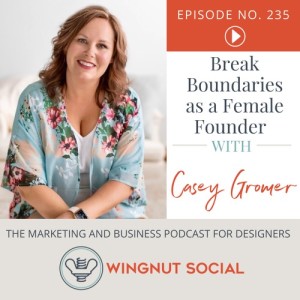
Wednesday Sep 22, 2021
Wednesday Sep 22, 2021
Are you a female founder who’s tired of the hustle mentality? Do you feel like your mental burden is becoming too much to carry? Or maybe you’re a visionary dreamer stuck in the role of CEO? In this episode of Wingnut Social, Casey Gromer shares how you can step away from being the “boss” and still be a passionate and purposeful leader of your business.
What You’ll Hear On This Episode of Wingnut Social
[1:49] I just bought a new house!
[3:49] Mini News Sesh: How Instagram search works
[9:21] Learn all about Casey Gromer
[11:29] What you’re doing wrong with vision statements
[19:15] Outdated leadership structures don't work for women
[24:30] Check out Build Lane for custom furniture!
[25:57] Learn more about the Wingnut Social Marketing Agency
[32:12] The difference between being a CEO and a visionary leader
[37:17] The steps to take to move out of day-to-day operations
[39:48] The What Up Wingnut Round!
[42:40] How to learn more about Casey Gromer
[47:07] Blooper Reel!
Connect with Casey Gromer
The SHE Suite Boutique
Connect with Casey on LinkedIn
Casey’s book: A Fresh Wave of Marketing
Casey’s podcast: Female Founders Breaking Boundaries
Resources & People Mentioned
Start with Why by Simon Sinek
Rocket Fuel by Gino Wickman
Toss out outdated leadership structures that don't work for women
When Casey left the corporate world and went out on her own, she realized the advice that women are getting didn’t work. Why? The hustle mentality. As a woman and mom, you’re likely raising kids, taking care of your home, and working full-time. Women need a flexible structure for their work and life. But that often isn’t the case, so women carry a large mental load. Corporate environments put work first and leave everything else to come second. That mentality doesn’t fly for most women—it can’t.
Casey emphasizes that “We’ve created a society where if we’re not hustling, we’re not worthy of making the money.” Women hustle just as much as men—but not all 120 hours of hustle are dedicated to the business. Yet women feel they don’t deserve to get paid when all of their time and energy isn’t focused on hustling. That needs to change.
It’s a new concept that you can build a business where you can step away and have other people run it and take ownership. As long as you’re working with a team toward the same vision, it doesn’t matter if you’re the one doing all the things. You’re still the owner of the business.
The difference between being a CEO and a visionary leader
Your typical CEO is someone who is a leader, a planner, an executor, well-organized, and knows what’s happening in the business at all times. They get stuff done. That’s where Casey feels her sweet spot is. But a visionary leader is an idea person. They have 100 ideas a day, hate being tied to a desk, don’t like being responsible for people, etc. These are the people that start amazing companies and get burned out.
The CEO doesn’t generate ideas so their business tends to stay stagnant. They don’t get to dream about tomorrow. That’s why you have to partner with visionary-style leaders and allow them to dream. Casey partners with visionaries so they can dream and she can plan and execute.
If you’re a female founder who’s ready to step back from the day-to-day and leave behind the hustle mentality, Casey has some tips for you. Ask yourself these simple questions:
What are the major functions that keep your business running?
What’s involved in each function?
What are you good at and what should be delegated?
But even before you do this, Casey implores you to get an assistant that can make sure your ideas have a place to go who works to keep you organized and focused.
To hear a full discussion about crafting a vision statement for your company that actually works, listen to the whole episode!
Connect With Darla & Wingnut Social
www.WingnutSocial.com
On Facebook
On Twitter: @WingnutSocial
On Instagram: @WingnutSocial
Darla’s Interior Design Website
Check out the Wingnut Social Media Lab Facebook Group!
1-877-WINGNUT (connect with us for your social media marketing needs)
Wingnut Social Podcast Sponsor: Build Lane
Looking for a great custom furniture option? Check out Build Lane: https://buildlane.com/
Subscribe to The Wingnut Social Podcast on iTunes, Google Podcasts, or TuneIn
Audio Production and Show notes byPODCAST FAST TRACKhttps://www.podcastfasttrack.com
![Convert Calls to Clients with Nikki Rausch [Throwback] - Episode 234](https://pbcdn1.podbean.com/imglogo/ep-logo/pbblog3132020/36248E8F-9ACE-413E-A840-F6E170FCEC1A_300x300.jpeg)
Wednesday Sep 15, 2021
Wednesday Sep 15, 2021
Discovery calls. You’ve all had these conversations with prospective clients, right? Identifying whether or not they’re a good fit for your brand and business can be tricky. In this Wingnut Social throwback, Nikki Rausch shares how to ask the right questions—not only to determine if they’re a good fit—but to close a new client. Don’t miss it!



